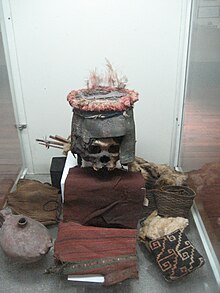Chinchorro culture

Chinchorro is the name for a South American cultural complex that was supported by a hunter-gatherer people. The Chinchorros lived in northern Chile and southern Peru around the waterholes of the Atacama desert , as well as on the coast of the Pacific, and lived mainly from fishing. They became known for their elaborately prepared children's mummies , otherwise little is known about them.
It has remained unclear to science why the simply living nomads practiced such a highly developed, elaborate death ritual . Today we know that in northern Chile there is a naturally high concentration of arsenic in drinking water. The resulting high child mortality rate may have led to the bizarre practices. Initially, the children's corpses were only covered with clay and dried in the sun, later the entrails were removed, the bodies were filled with plants and decorated.
Dating
The first Chinchorro mummies were found in the Atacama Desert as early as the beginning of the 20th century, but they only attracted worldwide attention after the discovery of 96 mummies at the foot of a rock massif above the Chilean city of Arica in 1983. By 1995, Inacama a total of 282 Chinchorro mummies recovered from burial sites, 149 of which were artificially mummified , while the remaining 133 are the result of natural mummification . The oldest known Chinchorro mummy is the so-called Hombre de Acha (Acha man), whose age was determined to be around 9,000 years using the radiocarbon method. It was found in the Acha Gorge on the outskirts of Arica, near a cooking stove in the middle of eleven circular stone foundations that formed the oldest documented Chinchorro settlement. The oldest artificial mummy - a child's corpse from the Valle de Camarones - could be dated around 5050 BC. To be dated. In the following 3500 years different styles of mummies developed until the practice of mummification among the Chinchorro around 1500 BC. Came to a standstill.
Origin of name
The name "Chinchorro" is derived from a stretch of beach where mummies of this culture were found in the 1960s. According to another explanation, which does not have to be a contradiction, the name is derived from a designation for fishing boats.
Individual evidence
- ^ Charles C. Mann : 1491: New Revelations of the Americas Before Columbus. 2nd Edition. Vintage Books, New York 2011, p. 204.
- ↑ Bernardo Arriaza: Chile's Chinchorro Mummies. In: National Geographic . Volume 187, No. 3, March 1995.
- ^ Chinchorro Culture , archeology.about.com, accessed March 11, 2015 and Chile's Chinchorro Mummies , National Geographic Online, published March 1995
literature
- Adventure archeology. Cultures, people, monuments. Spectrum of Science Verl.-Ges., Heidelberg 2006, 1, p. 9. ISSN 1612-9954
- Atacama Desert: The Enigmatic Transformation of Children's Mummies , Der Spiegel Online, March 11, 2015
- Nuria Sanz, Bernardo T. Arriaza, Vivien G. Standen (Eds.): The Chinchorro culture. A comparative perspective, the archeology of the earliest human mummification , UNESCO, Paris 2014.
